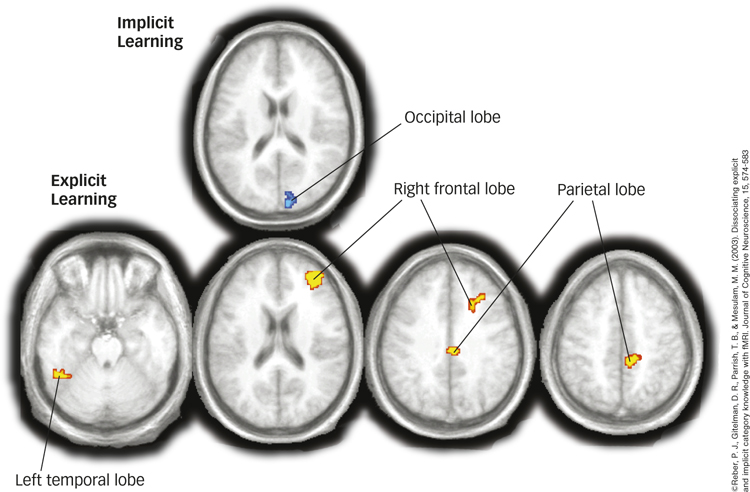7.4 Implicit Learning: Under the Wires

Most people are attuned to linguistic, social, emotional, or sensorimotor events in the world around them so much so that they gradually build up internal representations of those patterns that were acquired without explicit awareness. This process is often called implicit learning, or learning that takes place largely independent of awareness of both the process and the products of information acquisition. Because it occurs without awareness, implicit learning is knowledge that sneaks in “under the wires.”
implicit learning
Learning that takes place largely independent of awareness of both the process and the products of information acquisition.
How are learning and memory linked?
Habituation, which we discussed at the outset of the chapter, is a very simple kind of implicit learning in which repeated exposure to a stimulus results in a reduced response. In contrast, some forms of learning start out explicitly but become more implicit over time. When you first learned to drive a car, for example, you probably devoted a lot of attention to the many movements and sequences that needed to be carried out simultaneously (“step lightly on the accelerator while you push the turn indicator and look in the rearview mirror while you turn the steering wheel”). That complex interplay of motions is now probably quite effortless and automatic for you. Explicit learning has become implicit over time. These distinctions in learning might remind you of similar distinctions in memory and for good reason. In the Memory chapter, you read about the differences between implicit and explicit memories. Do implicit and explicit learning mirror implicit and explicit memory? It’s not that simple, but it is true that learning and memory are inextricably linked. Learning produces memories, and conversely, the existence of memories implies that knowledge was acquired, that experience was registered and recorded in the brain, or that learning has taken place.
235
Cognitive Approaches to Implicit Learning
Most children, by the time they are 6 or 7 years old, are linguistically and socially fairly sophisticated. Yet most children have very little explicit awareness of when or how they learned a particular course of action and may not even be able to state the general principle underlying their behavior. Yet most kids have learned not to eat with their feet, to listen when they are spoken to, and not to kick the dog.
To investigate implicit learning in the laboratory, researchers in early studies showed participants 15 or 20 letter strings and asked them to memorize them. The letter strings, which at first glance look like nonsense syllables, were actually formed using a complex set of rules called an artificial grammar (see FIGURE 7.16). Participants were not told anything about the rules, but with experience, they gradually developed a vague, intuitive sense of the “correctness” of particular letter groupings, and they could get between 60–

Why are tasks learned implicitly difficult to explain to others?
Other studies of implicit learning have used a serial reaction time task (Nissen & Bullemer, 1987). Here research participants are presented with five small boxes on a computer screen. Each box lights up briefly, and when it does, the participant is asked to press the button that is just underneath that box as quickly as possible. Like the artificial grammar task, the sequence of lights appears to be random, but in fact, it follows a pattern. Research participants eventually get faster with practice as they learn to anticipate which box is most likely to light up next. But, if asked, they are generally unaware that there is a pattern to the lights.
Implicit learning is remarkably resistant to disorders that are known to affect explicit learning. For example, profoundly amnesic patients display virtually normal implicit learning of artificial grammar (Knowlton, Ramus, & Squire, 1992), even though they have essentially no explicit memory of having been in the learning phase of the experiment! In contrast, several studies have shown that dyslexic children, who fail to acquire reading skills despite normal intelligence and good educational opportunities, exhibit deficits in implicit learning of artificial grammars (Pavlidou, Williams, & Kelly, 2009) and motor and spatial sequences on the serial reaction time task (Bennett et al., 2008; Orban, Lungu, & Doyon, 2008; Stoodley et al., 2008). These findings suggest that problems with implicit learning play an important role in developmental dyslexia and need to be taken into account when developing remedial programs (Stoodley et al., 2008).
236
Implicit and Explicit Learning Use Distinct Neural Pathways
The fact that individuals suffering amnesia show intact implicit learning strongly suggests that the brain structures that underlie implicit learning are distinct from those that underlie explicit learning. As we learned in the Memory chapter, amnesic individuals generally show signs of lesions in the hippocampus and nearby structures in the medial temporal lobe; accordingly, these regions are not necessary for implicit learning (Bayley, Frascino, & Squire, 2005).
For example, in one study, participants saw a series of dot patterns, each of which looked like an array of stars in the night sky (Reber et al., 2003). Actually, all the stimuli were constructed to conform to an underlying prototypical dot pattern. The dots, however, varied so much that it was virtually impossible for a viewer to guess that they all had this common structure. Before the experiment began, half of the participants were told about the existence of the prototype; in other words, they were given instructions that encouraged explicit processing. The others were given standard implicit learning instructions: They were told nothing other than to attend to the dot patterns.
The participants were then asked to categorize new dot patterns into those that conformed to the prototype and those that did not. Interestingly, both groups performed equally well on this task, correctly classifying about 65% of the new dot patterns. However, brain scans revealed that the two groups were making these decisions using very different parts of their brains (see FIGURE 7.17). Participants who were given the explicit instructions showed increased brain activity in the frontal cortex, parietal cortex, hippocampus, and a variety of other areas known to be associated with the processing of explicit memories. Those given the implicit instructions showed decreased brain activation primarily in the occipital region, which is involved in visual processing. This finding suggests that participants recruited distinct brain structures in different ways depending on whether they were approaching the task using explicit or implicit learning.

237
SUMMARY QUIZ [7.4]
Question 7.11
| 1. | What kind of learning takes place largely independent of awareness of both the process and the products of information acquisition? |
- latent learning
- implicit learning
- observational learning
- conscious learning
b.
Question 7.12
| 2. | Which of the following statements about implicit learning is inaccurate? |
- Some forms of learning start out as explicit but become more implicit over time.
- Implicit learning occurs even in the simplest organisms.
- People with amnesia tend to be severely impaired at implicit learning tasks.
- Children learn language and social conduct largely through implicit learning.
c.
Question 7.13
| 3. | Responding to implicit instructions results in decreased brain activation in which part of the brain? |
- the hippocampus
- the parietal cortex
- the prefrontal cortex
- the occipital region
d.